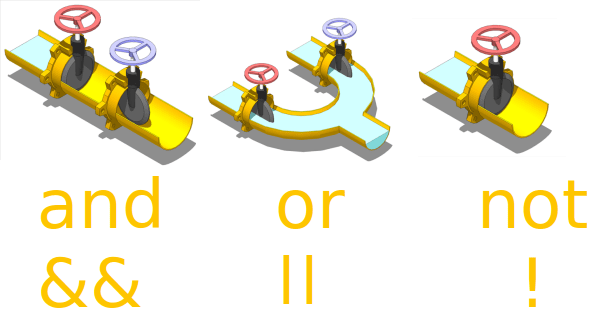Logical Operators
Logical operators are used to check conditions with multiple expressions, e.g. in comparison operations.
Type casting
In logical operations, the types of operands are converted/cast to true or false. Casting occurs if a logical operator is found in the code.
Truthy and Falsy are the terms used for those values that are converted to true or false in a logical operation, although they were not originally booleans.
Remember the 6 falsy values that are converted to false in logical conversion: 0, NaN, null, undefined, empty string and false. Everything else is converted to true.
Logical operators
There are three logical operators that are used to check the execution of multiple expressions.

Logical AND
The && operator converts all operands to a boolean and returns the value of one of them. The left operand if it can be converted to false, or the right operand otherwise.
expression && expression
In the following example, both conditions will return true, so the result of the whole expression will be true, and the value of the right operand will be returned.
const age = 20;
console.log(age > 10 && age < 30); // true && true -> true
If at least one of the operands is converted to false, the expression will result in its value.
const age = 50;
console.log(age > 10 && age < 30); // true && false -> false
console.log(age > 80 && age < 120); // false && true -> false
That is, the logical AND stumbles on false and returns what it stumbles on or the last operand.
console.log(1 && 5); // true && true -> 5
console.log(5 && 1); // true && true -> 1
console.log(0 && 2); // false && true -> 0
console.log(2 && 0); // true && false -> 0
console.log("" && "Mango"); // false && true -> ""
console.log("Mango" && ""); // true && false -> ""
console.log("Mango" && "Poly"); // true && true -> "Poly"
console.log("Poly" && "Mango"); // true && true -> "Mango"
When executing the logical AND, evaluating the right operand is not required if the left one is converted to false.
Logical OR
The || operator converts all operands to a boolean and returns the value of one of them: the left operand if it can be converted to true, the right operand otherwise.
expression || expression
In the following example, the condition will return true, so the result of the whole expression will be true, and the value of the first operand (converted to true) will be returned.
const age = 5;
console.log(age < 10 || age > 30); // true || false -> true
The result will also be true, since at least one of the operands, in this case the right one, is converted to true.
const age = 40;
console.log(age < 10 || age > 30); // false || true -> true
None of the conditions is met, so you get false, i.e. the value of the last operand.
const age = 20;
console.log(age < 10 || age > 30); // false || false -> false
That is, the logical OR stumbles on true and returns what it stumbles on or the last operand.
console.log(true || false); // true
console.log(false || true); // true
console.log(true || true); // true
console.log(3 || false); // 3
console.log(false || 3); // 3
console.log(3 || true); // 3
console.log(true || 3); // true
When executing the logical OR, evaluating the right operand is not required if the left one is converted to true.
Logical NOT
All the operators above are binary, containing two operands, left and right. The logical NOT is a unary operator, operating with just one operand on the right.
!expression
The ! operator converts the operand to a boolean, if necessary, and then inverses, i.e. replaces it with the opposite true -> false or false -> true.
console.log(!true); // false
console.log(!false); // true
console.log(!3); // !3 -> !true -> false
console.log(!"Mango"); // !"Mango" -> !true -> false
console.log(!0); // !0 -> !false -> true
console.log(!""); // !"" -> !false -> true
const isOnline = true;
const isNotOnline = !isOnline; // !isOnline -> !true -> false